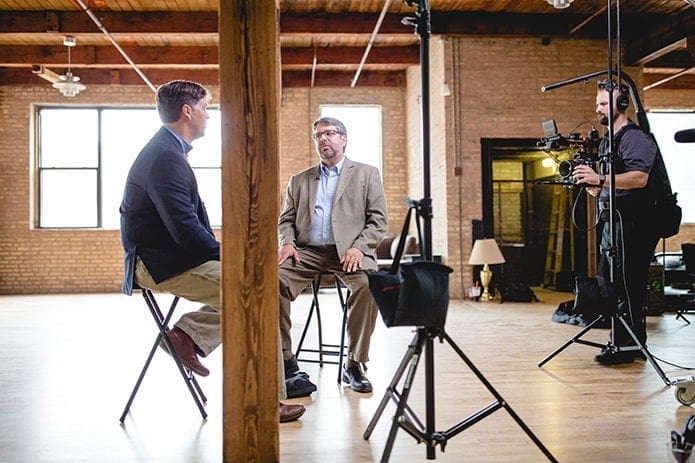 Photo By Spirit Juice Studios
Photo By Spirit Juice StudiosSmyrna
New video series supports youth leaders who ‘accompany’ teens
By PRISCILLA GREEAR Special to the Bulletin | Published November 2, 2017 | En Español
SMYRNA—The Office of Faith Formation and Discipleship of the Archdiocese of Atlanta has launched the first video training series based on the U.S. Conference of Catholic Bishops’ framework for youth ministry. A nationwide collaboration, the series is a pithy digital fusion of creative juices to bolster volunteers who are “Called to Accompany” youth.
The archdiocese worked on the series with the Emmy-winning Spirit Juice Studios of Chicago and national youth ministry experts from New York to Montana, with funding support from the North Georgia Catholic Foundation and Our Sunday Visitor.
Together, collaborators blended insights, personal testimonies and dialogues to craft 10 videos in English and Spanish on fundamental topics including evangelization, pastoral care, marginalized youth and diversity. Project leaders hope that the youth ministry 101 films and accompanying comprehensive study guides will serve as a practical parish training resource nationwide.

“Called to Accompany”—“Llamados a Acompañar” in Spanish—was launched Oct. 25 on the new archdiocesan website www.atlyouth.org. The site also features upcoming youth events plus The Mark magazine for teens. Launched in fall 2016, the first issue of the magazine garnered more than 19,000 page views with 8,000 print copies made available to confirmation students.
The new training series covers four of the eight USCCB “Renewing the Vision” pillars of youth ministry and will be promoted by the National Federation for Catholic Youth Ministry. It complements any existing youth ministry program, and the Spanish videos feature Hispanic leaders discussing culturally specific issues.
“I’m extremely excited because it’s one of the most needed tools in all parishes in our archdiocese and around the nation. The reason is there is no training for volunteers in English and Spanish based on the pillars of youth ministry, not based on a program,” said project architect Katherine Angulo, associate director of youth ministry for the archdiocese. “Most in youth ministry are either part-time or volunteers and need to get trained to do the important job of passing the faith to the next generation. They are going to be trained by the best of the best to give them an understanding of what comprises youth ministry, so they will understand the purpose of their job and be less stressed.”
The director of the Office of Faith Formation and Discipleship, Amy Daniels, called it a “huge collaboration” with many in her office participating, including the website’s designer, Patrick Metts. The new format will enable busy volunteers who can’t always make diocesan training sessions to watch videos on their own schedule or view them and discuss with study guides at their parishes.
“It’s meeting a need that we have and typically if it’s meeting a need that we have, we’re not the only ones,” Daniels said. “The need, matched with the quality of the product, I believe will benefit all of the archdiocese and beyond as well.”
And “Called to Accompany” is free, easy and user-friendly.
“Download the study guide and click on the video that goes with it,” said Daniels. “And free, that’s the name of the game in the church today. Small parishes, few-to-no resources, and they already have volunteer leadership but don’t have the money to buy programs and training.”
Angulo has met one too many youth ministers who received no direction, tried to serve effectively but ultimately quit.
“We take their work seriously, and we are grateful for every single minute that they donate to the church as volunteers. Because of that we are investing in them nationally and in production. They can have a more fruitful experience,” she said. “We are struggling tremendously for recruiting volunteers for any ministry in the church and many times it’s because of the fears that we have, we think we don’t know enough, we think that we don’t have anything to give … These videos assure volunteers that no matter what level they are, if they are open to serve the church, the teens will benefit tremendously by their presence.”
Videos inspire with engaging images, messages
Spirit Juice crews started filming in Chicago in August 2016. Since then, the team has produced 23 total videos, each up to seven minutes in length. The first video introduces the vision of youth ministry, Generation Z and volunteer qualities. Producers aimed to keep the series vibrant and engaging by infusing colorful visuals, nature settings and character images to enhance messages. In one video, Spanish presenter Armondo Cervantes strolls by a lake and picks up dirt while discussing how Jesus placed mud on the eyes of the blind Bartimaeus.
“Just hearing them talk about the subject and their engagement in their faith has really kind of been an inspiration to my own faith,” said production manager Greg Krajewski, of Spirit Juice. “There can be a lot of negativity these days, but to see these people who are so passionate about the youth, and bringing up the youth and continuing the faith is really kind of an inspiration to me in why we’re doing this.”
Krajewski first filmed Doug Tooke, executive director of Reach Youth Ministry, on the topic of evangelization.
“I like that message that these teens are searching for something real and authentic in this world, and Doug did a great job in explaining to these volunteers … what’s appropriate sharing of your story and being authentic in your faith story and encouraging volunteers to live their faith and foster their own faith,” said Krajewski.
In a dialogue, Tooke invites “formers” of youth into a deeper prayer life through which they’ll naturally become more compelling witnesses.
“The old adage, ‘we can’t give what we don’t have,’ has played itself out in the church, and if we are not prayers we are not inviting people to anything, so it really becomes the onus of spiritual growth first and then expression,” Tooke said about his video message. “As Catholics we have to push ourselves spiritually to know the word, to get into the language of Christ so that vocabulary can be how we teach and what we invite young people into.”
Tooke cites how Jesus accompanied young people on the Road to Emmaus.

Father Joseph Espaillat, left, the spiritual director for the Archdiocese of New York’s Office of Youth Ministry, and Katherine Angulo, associate director of youth ministry for the Archdiocese of Atlanta, are two of the four bilingual presenters for the new training series for youth ministry volunteers, “Called To Accompany.” The Archdiocese of Atlanta’s Office of Formation and Discipleship unveiled the program Oct. 25. Photo By Spirit Juice Studios
“Christ’s first inclination is to just listen and ask them their version of the story and then Christ gives his authentic witness, the greatest Bible study in the history of Bible studies, in salvation history, but all the while walking with the young people no matter their experience. And then there’s a Eucharistic moment and a revelation,” he said. “There has to be a keen sense of listenership to the uniqueness of their story with you, the former of the faith, still being very true to who you are.”
Teens must learn to give their daily struggles to Christ, said Tooke.
“Catechesis is extremely important—but to also teach young people spirituality. The 16-year-old is the 24-year-old tomorrow and if they don’t have a personal relationship with Christ and a means of communication, a prayer life, they associate youth ministry with adolescence—and now they’re an adult and they’re not growing,” Tooke reflected.
It’s to “really invite them to cut their teeth as disciples and to walk the road,” he added.
Spanish versions address ‘needs of the culture’
Angulo, a native of Colombia, spoke on diversity and edited the Spanish films. She noted that many newly arrived immigrant parents are focused on survival.
“These kids don’t have anybody talking to them about their faith—that’s why we’re struggling with this next generation, that’s why we need volunteers who are willing to share their faith so they can hear it—otherwise they won’t,” she said.
The Spanish versions “are not a literal translation but addressing the realities of Hispanic ministry in the U.S. and the specific needs of the culture,” she said.
The Archdiocese of New York’s executive director of the department of youth faith formation, Ela Milewska, speaks on pastoral topics, such as what is acceptable ministry and identifying troubled teens needing intervention.
“We’re youth ministers, not therapists, and our job is a ministry of presence which means making sure young people and their families get the help that they need by really qualified people,” she said.
With the launch, Milewska is grateful to have an empowering new tool for New York volunteers.
“We are already planning on how we’re going to use this in our archdiocese with our training with our youth ministry adults. We’re so excited because I know the quality of people she has involved in this, the quality of the videography, the company she used, and so this is really a gift not only to (Atlanta) youth ministers but really a gift to every youth minister in the country.”